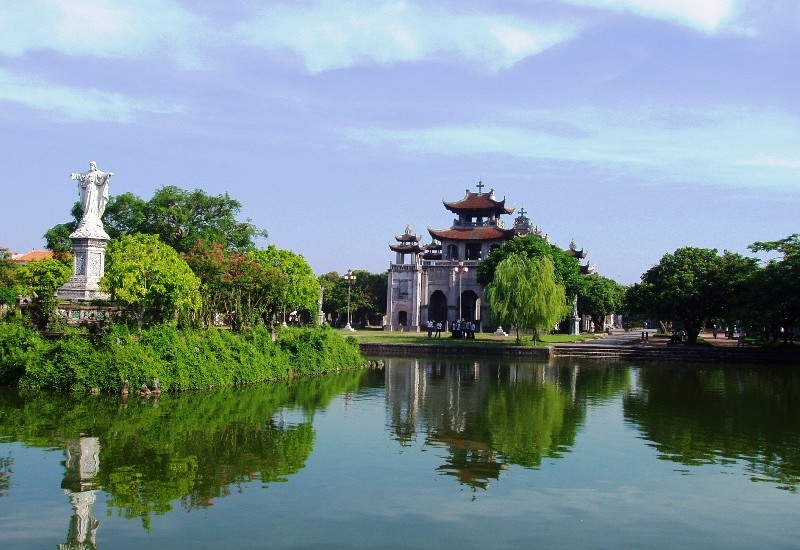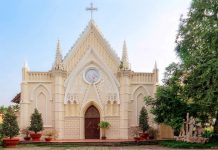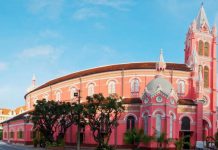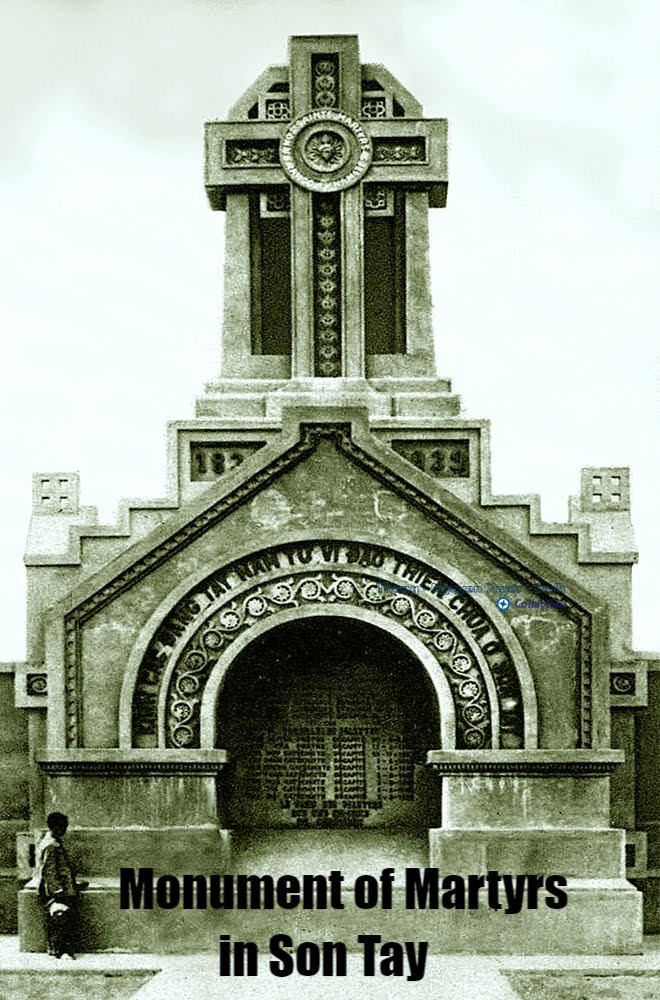[toc]
Phát Diệm Cathedral is one of Vietnamese architectural masterpieces, covering over two hectares (five acres) and consisting of a lake, a grand Cathedral with five separate side chapels, three artificial grottoes, and a majestic bell tower named Phương Ðình.
Of special interest for the visitor to this particular Catholic Church, is its unique style of architecture, which resembles a budhist temple or pagoda, characterized by several tiers of over hanging curved roofs.
The building of Phát Diệm Cathedral was the work of Father Trần Lục, more popularly known as Father Six, the then parish priest of Phát Diệm, and was accomplished in twenty four years (1875-1899). Phát Diệm was a simple parish, eventually becoming the seat of the new diocese in 1901. doubtless to say, had Phát Diệm Cathedral been built by a European missionary, it would probably resemble most other Catholic churches of the time. Instead, it has become one of the most uniquely important churches ever to be built in Asia in the Far-Eastern architecture.
The following is a more detailed description of the Cathedral complex.
THE BELL TOWER
The Bell Tower is an imposing stone structure standing majestically near the lake, and resembling the communal house of most Vietnamese villages. It is an almost square building with a spacious interior, and was purposely built without doors. Above the central entrance the visitor can see four large chinese characters translated as: “Precious Seat of the Holy Body”. The smaller chinese characters indicate the date of the building, Holy Thursday, 1899. On the opposite side a Latin inscription reads: “Capella in Cœna Domini”, or: “Chapel for the last Supper”.
In the center of each of three compartments is a slab of stone, serving as a large common seat-Vietnamese sit upright with crossed legs on the flat surface- the large slab in the middle compartment is said to have belonged to the royal hall of Tây Giai, Citadel, Thanh Hoá.
On the walls can be seen low stone reliefs depicting Saints, with bamboo shaped stone bars on the windows. Narrow steps lead the visitor to the first floor, where hangs a great tam-tam (drum), used only on Sundays and Feast days as an accompanyment to the bell. A ladder leads up to the top floor where hangs a two-ton bell, which when struck by means of a wooden ram, can be heard as far away as ten kilometres around. Also from the top floor the visitor can see twenty churches scattered in the region, and on a clear day, the sea in the south, and the mountain range to the west.
The Bell Tower was the last monument to be built in the complex, and according to many critics it is also the finest one. It was finished in 1899, which was also the year of Father Six’ death. Over 40,000 people attended Father Six’ funeral, his tomb is located in the courtyard between the Bell Tower and the Cathedral.
THE CATHEDRAL

Upon reaching the courtyard, the visitor cannot help but be inspired by the Cathedral. As the Bell Towerr was colossal, the stone façade of the Cathedral is elegant. A memorial stela on the right bears a hymn in Latin in honour of Mary, and the dedication of the Cathedral ot Our Lady of Holy Rosary, signed by Father Six A.D.1891.
On top of the central tower, we see two Angels holding up the cross, two others blowing trumpets and four characters meaning: “Foreboding of Judgement Day”. The towers are made of bricks. The five porches are made of stone. The central porch is a large slab carved into an elaborate rose bush spreading its twigs, among which appear seventeen Angels. Above the porches are fifteen stone reliefs representing episodes from the lives of Jesus and Mary-15 mysteries of the Rosary. Five entrances, 9 m deep (291/2 feet) built of stone, lead to five massive carved wood doors.
Above each Angel holding a holy water basin is a sentence in Latin telling the right attitudes a Christian must have when he comes to pray.
When one penetrates inside, one is impressed by the dim and quietness of the interior, and the pleasant sense of warmth radiating from the wood construction and decoration.
What immediately catches one’s eye are the two rows of huge pillars leading to the sanctuary, which is splendily decorated with chiseled woodwork, lacquered and gilded. Many more pillars are to be seen.
The roof rests on 52 iron wood pillars 16 of which are 11 metres high, 2,60 metres in circumference and 7 tons in weight.

In the sanctuary, a statue of “Our Lady with Infant Jesus” is prominent. On both sides are pictures of Saints. On the glass windows above, are pictures of six Martyrs, five are Vietnamese and one is European. The top picture is Our Lady giving the Rosary to St. Dominic. The pictures and the statue, dominantly painted blue, suggest a big cross. The lacquered and gilded woodwork keeps amazingly well after a hundred years and war damage not withstanding.
The old altar in the rear, was cut in a single block of white stone, meticulously chiseled. The front altar is new; made of a single slab, consecrated on 6th October, 1991, the 100the Anniversary of the Cathedral.
From outside, on the side wall near the façade, one can see two windows made of stone and carved into the form of a lion.
THE CHAPELS AND GROTTOES

All around the Cathedral, Father Six built four Chapels. A fifth, the “Stone Chapel” was constructed a little farther away. One writer has compared them to beautiful “Ladies in waiting”, attendants to the queen. One might also say “Four altar servers” assisting the ceelebrant. They are similar in structure, but each has its own features as follows.
Saint Joseph’s (9)- the front Chapel on the west side- was built entirely of iron wood. On both walls of choir are stone reliefs depicting episodes from Saint Joseph’s life.

Saint Peter’s (10) – directly behind Saint Joseph’s- was built of jack wood fruit, and Father Six dedicated it to his patron Saint. The tympanum of the central porch is worth seeing. On the choir above the windows decorated with stone bars, are reliefs portraying twelve Apostles, whose names are written in Ancient Vietnamese script. The altar is made out of a single block of stone weighing twenty tons.

The Immaculate Heart (11) – the “Stone Chapel”, north-west of Saint Peter’s was the first Chapel to be built by Father Six and was constructed in 1883. Everything was made of stone, floors, pillars, beams, walls, window bars, towers and altar. The façade has two lateral towers with many stories which taper towards the top, like the Tháp Búp tower at Restored Sword Lake in Hà Nội. Above the niche in the central tower is engraved an invocation to the “Immaculate Heart of Mary” in four languages. The first line is Vietnamese, and is the unique inscription in the Vietnamese language to be found in the whole Cathedral complex until 1991. Although made of stone, the interior looks light and graceful thanks to glossy marble decoration beautiful windows and scultptures. From outside, one can see a phoenix, and a lion which has a smiling human face. The “Stone Chapel” is worth the label “gem” given by a noted person.


The Calvary Grotto (12) is in front of the “Stone Chapel”.
The Bethlehem Grotto (13) – East of the Calvary grotto – was originally named the Sepulchre Grotto, and was built by Father Six in 1875 to test the solidity of the soil before starting other construction.

The Lourdes Grotto (16) – East of the Bethlehem Grotto.

On the way to Lourdes Grotto, visitors may stop (14) to have a view of the Bishop’s House (15) in the Nord, the right wing of the old two-story house was built by Father Six one hundred years ago. Look back to the Cathedral chevet and one can see three stone windows decorated with sculptured phoenix. This Grotto stands in a picturesque setting, topped by a secular tree. Under the tree is the tomb of two parish priests of Phát Diệm and layman, martyred in the 19th century.
The statue of “Our Lady of Lourdes” is the gift of a missionary in Yun-Nan, China.
The Sacred Heart Chapel (17) – East side of the Cathedral. Its interest lies in its three-tower façade and its meticulously sculptured doors. It is said that a high French official asked Father Six to take these doors to an exhibition in Paris, but he refusedd for the reason that they were offered to God in perpetuity.

Saint Roch’s (18)- South of the Sacred Heart Chapel-built in 1895, was originally dedicated to St. John the Baptist but was renamed out of gratitude to St. Roch for his deliverance from an epidemic of cholera in 1923. Except for the altar, which is made of a single slab of stone, the parts are of jack wood fruit.

From: http://phatdiem.org/Portal/Desktop.aspx?tabid=11&Culture=vi-VN&catID=1323















